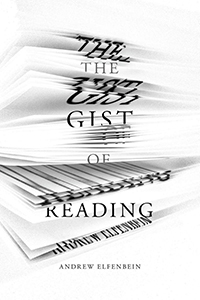How We Read
Reading is one of the most complex acts of the human mind: it involves everything from basic pattern recognition to complicated problem solving. Yet, while teaching reading to children receives great attention within schools of education, scholars in the humanities have been far less systematic in their understanding of adult reading. Literary scholars even use “reading” as a synonym for interpretation; in literary criticism, a reading of a poem or novel means not the act of reading it, but the interpretation of it according to strict disciplinary norms.

In The Gist of Reading (Stanford University Press), I wanted to bring reading, rather than interpretation, to the foreground, and to do so I went beyond the familiar vocabulary of literary criticism. I turned instead to empirical psychology, which presented me with an image of reading quite different from the one that I had known. Drawing on findings from this field as well as my own empirical and historical work on reading, I discovered a wide array of surprising insights while writing The Gist of Reading:
1
WHEN YOU REMEMBER A NOVEL, YOU DON'T REMEMBER THE NOVEL. By the time you reach the end of a book, you will have forgotten many, if not all, of the sentences it contains. Instead, if you have understood it well, you will have a mental model of it that contains major points and connections between them. But, more than that, your model may also include much that the book did not state explicitly: inferences about character’s motivations and feelings; autobiographical associations; emotional experiences. None of these are “in” the book, but they can become part of your memory of it. That memory is what I mean by “gist.” I use it to foreground the difference between the work itself and what readers make of the work in their long-term memory.
2
EVERY TIME YOU REMEMBER A BOOK, IT IS DIFFERENT. Your memory is not like a closet where you store clothes: every time you reach for a pair of pants, it is the same pair of pants. But you construct your memory of a book to fit an occasion: you remember for a purpose, and that purpose shapes your memory. Having remembered a book once means that future memories arise not just from your original experience but also from the subsequent experiences of remembering it. If you find a book easy to remember, you probably have remembered it often.
Even when readers are
explicitly warned that
what they are reading
contains inaccurate
information, they still
accept misinformation
as true.
3
READING LITERATURE AND READING EMAIL ARE DIFFERENT, BUT NOT AS DIFFERENT AS YOU MIGHT THINK. Literary scholars have assumed that literary reading is a category to itself, entirely different from ordinary reading. While some aspects of literary reading are special (such as the extra effort required to read a long novel or to understand densely figurative poetry), much about literary and nonliterary reading is similar. In both cases, you connect major ideas, make inferences, monitor your understanding, inhibit distractions (more or less successfully), and create a mental model that is coherent and usable.
4
YOU CAN READ WITHOUT READING. In what is called “masked priming,” scientists present two words in succession to readers; the first is the “prime,” and the second is the “target.” When the prime is related to the target, readers read the target more quickly than if the prime is not related to the target. For example, if the prime is a word in lower-case letters and the target is the same word in upper-case letters, readers read the target more quickly. Likewise, if the prime is semantically linked to the target (like “cat-dog”), readers read the target more quickly. The surprise is that the prime matters even if it is presented for an exceptionally short time (as short as a twentieth of a second). This is so short that readers are not even aware that they have seen it. Nevertheless, they have registered it because experiencing it changes how quickly they read the target.

5
MISINFORMATION IN FICTION CAN LEAD PEOPLE TO FORGET FACTS THAT THEY HAVE PREVIOUSLY KNOWN. Readers easily accept misinformation. In one experiment, participants who had shown that they had correct knowledge about a series of facts read stories that contained incorrect versions of those facts. After reading, participants were more likely to have exchanged correct for incorrect facts. This effect is stubborn. Even when readers are explicitly warned that what they are reading contains inaccurate information, they still accept misinformation as true, even after having demonstrated prior knowledge of the correct information.
Even when readers are explicitly warned that what they are reading contains inaccurate information, they still accept misinformation as true.
6
READERS LOVE READING FICTION EVEN WHEN THEY SHOULD NOT. Scholarship about reading history, especially in Britain and the United States, has detailed endless attacks on fiction reading in earlier centuries. Repeatedly, readers were warned that reading would corrupt their morals, lead them away from religion, and waste their time. One might expect that these relentless attacks would have discouraged historical readers. Yet after reading hundreds of accounts of reading, I can say that the anti-novel language had few, if any, visible effects on real readers. Victorian readers read widely and, for the most part, enjoyed what they read.
7
AMERICAN HIGH SCHOOLS PIONEERED THE SERIOUS ANALYSIS OF FICTION. Traditionally, no one has treated American high schools as sources of serious academic study. But this is a mistake, because they were pioneers for literary criticism. After the number of American high schools skyrocketed in the late nineteenth century, college admissions became more competitive, and high schools changed their curriculum to help students get in. With this change came intensive study of certain literary classics. College professors and high school teachers created many editions of these classics with detailed editorial help and classroom exercises. Even after a hundred years, these editions remain models of smart pedagogy.
8
READERS MAY REMEMBER THE EXPERIENCE OF READING A NOVEL LONG AFTER THEY HAVE FORGOTTEN WHAT HAPPENS IN IT. In both literary criticism and psychology, memory for reading usually means how much a reader recalls about what happens in a work. Yet in my research on real readers, I discovered that, outside of the laboratory, the environment in which readers read heavily colors their memories. Often, remembering where something was read overwhelms any recollection of what was read. Psychologists call this phenomenon “environmental encoding,” and my book is the first to take it seriously as an aspect of reading.
The environment in which readers read heavily colors their memories.
9
THERE IS A FORMULA FOR WHAT MAKES A STORY INTERESTING. The psychologist Walter Kintsch hypothesizes that an interesting story has two major ingredients: its events are not predictable while you are reading, but, once you have finished, they are “postdictable,” meaning that they make sense in retrospect. A predictable story is not interesting; an unpredictable story that makes no sense in retrospect also fails to interest. Stories that sustain interest combine the right level of unpredictability during reading with the right level of postdictability after reading.
10
AUTHORS ARE INFLUENCED NOT BY WHAT THEY HAVE READ BUT BY WHAT THEY REMEMBER OF WHAT THEY HAVE READ. For works to influence authors, it is not enough for them to have read the works: they have to remember them. As I have noted above, memory for a work differs dramatically from the work itself. Studying influence by looking for analogous passages in different authors misses this basic point. My book shows a different way to analyze influence by taking seriously how long-term memory for literary texts happens.
The Gist of Reading offers a new perspective on reading by sharing new research, offering new vocabulary and concepts, and describing histories that, until now, have not been written. It challenges many long-held assumptions about what it means to read. Those who take it seriously will gain new ways of understanding not only their own reading process but why others read the way that they do.
This article was first published on the Stanford University Press blog.



